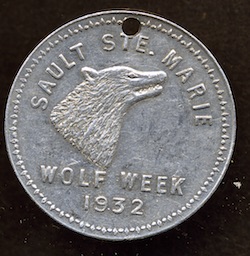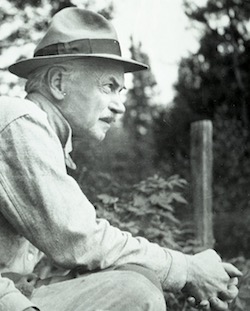 James Watson Curran sure made his mark.
James Watson Curran sure made his mark.
He had the idea for the first Community Day Parade (now known as RotaryFest), convinced Rudyard Kipling (Rudyard Kipling!) to write a poem for our cenotaph, and started something called Wolf Week.
How cool is that?
We hear he also owned a newspaper, or something.
From the Sault Ste. Marie Museum:
James Watson Curran, newspaper editor and author, was born in Armagh, Ireland, on April 24, 1865. When he was eight years old, his family emigrated to Canada, eventually settling in Orillia, Ontario. The Curran family was in the newspaper business and James' father owned two newspapers, the Essex Chronicle and the Orillia News-
In 1890, James moved to Toronto to work first as a reporter for the Toronto Empire and then as city editor. In 1895, he moved on to Montreal to become the city editor for the Montreal Herald. Six years later, while passing through Sault Ste. Marie, he became so impressed with the city that he quit his job at the Herald and bought "The Star", which at the time was a weekly newspaper.
He purchased the paper from Moses McFadden on August 31st, 1901. By 1912, Curran had turned The Star into a daily paper. After his death in 1952 his children continued the operation of the newspaper until 1975.
Curran was also a promoter of Sault Ste. Marie as an author and his two books "Here Was Vinland" (1939), and "Wolves Don't Bite" (1940), are examples of his enthusiasm for the region.
 J. W. Curran was one of the greatest promoters of Sault Ste. Marie. He did an immense amount of historical research and published many articles on the history of Sault Ste. Marie and surrounding area throughout the years.
J. W. Curran was one of the greatest promoters of Sault Ste. Marie. He did an immense amount of historical research and published many articles on the history of Sault Ste. Marie and surrounding area throughout the years.
As one of the original members of the Sault Ste. Marie Historical Society in 1920, he worked tirelessly to promote the organization and preserve our local history. He was also president of the Rotary Club in the early 1920s.
Community Day Parade (now Rotaryfest)
The first community day parade was held on the evening of September 22nd, 1922.
Eight thousand people took part and fifty vehicles were decorated for the parade.
J. W. Curran had seen a similar type of carnival while visiting Chicago and presented the idea to the Rotary Club.
After the first parade the festivities took place on the grounds of the court house and there was a street dance on Queen St.
Discovery Week - August 4th-8th, 1923
The Great War Veterans Association planned a reunion of soldiers and the unveiling of monument at the corner of Gore and Wellington streets to honour their fallen comrades. J. W. Curran mentioned to the Historical Society that it would a perfect opportunity to work with the Veterans Association and expand the festivities to include a celebration of the 300th Anniversary of Sault Ste. Marie.
Everything was agreed upon and the plans for "New Ontario Soldiers Reunion & Discovery Week" went forward.
More than 10,000 people attended the week-long event.
Some of the activities included the unveiling of the monument at Gore & Wellington streets, laying the cornerstone for the Civic War Memorial on the court house grounds, a reunion of people who were students and teachers in the late 1800s here in the Sault.
One of the larger projects undertaken by the Historical Society during Discovery Week was the installation of two monuments and eleven marble tablets celebrating the significance of the history of Sault Ste. Marie over the previous 300 years.
The federal government had plans to erect a cairn on the canal grounds to commemorate Brule's arrival at Sault Ste. Marie.
The Historical Society set a committee of members including J. W. Curran, Father Monahan, Mr. James Bassingthwaighte, T. E. Carmichael and Judge Stone.
Sacred Heart Church (now Precious Blood Cathedral) would erect a cairn and plaque to honour the Jesuit missionaries and their work.
The eleven marble tablets would be placed on various buildings along Queen street.
The committee canvassed local businesses and they or the owners agreed to fund the tablet being placed on their building.
The monuments and tablets were unveiled on August 8th, 1923 during a "motor car pilgrimage."
At each location the tablet was unveiled by various dignitaries.
Kipling Poem
During the planning of the Civic War Memorial, J. W. Curran contacted Rudyard Kipling to request that he compose a verse to be engraved on the base of the Cenotaph.
Kipling responded to Curran that he would be honoured to do so.
The verse on the cenotaph was composed just for Sault Ste. Marie.
Wolf Week - July 25th-30th, 1932
Another celebration to bring tourists and money to the Sault and to lift the morale of the citizens after the worst year of the Great Depression in 1931.
J. W. Curran suggested that plans be made to create a festival of events which would accomplish these goals.
Longfellow's Play - Hiawatha
The local Ojibway tribe from Garden River had performed the play on the shore of Lake Huron at Kensington Point in 1901. J. W. Curran encouraged them to revive the play during Wolf Week. The play was so successful that Curran worked with the group to have them perform the play at the Toronto Exhibition in 1937.
History Cabinet
At the offices of the Sault Star J. W. Curran kept a display cabinet which held items of historic interest brought in by local people. This became the "History Cabinet" and was maintained by Curran for many years.
This is a very brief overview of some of the things for which James Watson Curran deserves a great deal of credit for promoting our city and the importance of our unique heritage.
Find more entries here, and check out what the museum has to offer atwww.saultmuseum.com
You can also check out LOCAL2's new Friday feature, The LOCAL2 Time Machine, which features historical images and video courtesy the Sault Ste. Marie Museum.